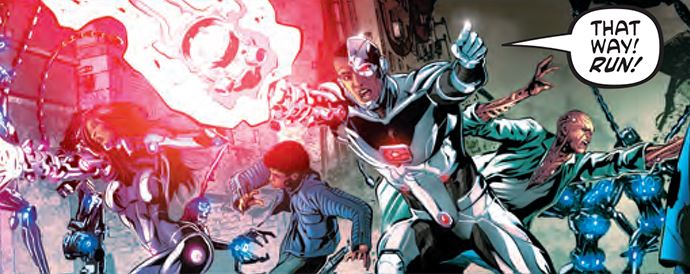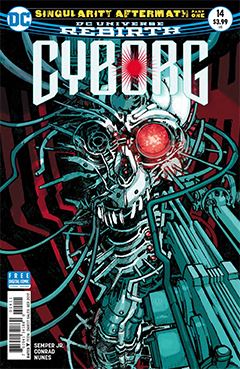- Comics
- Comics Reviews
- Manga
- Comics Reviews
- European Comics
- News
- Comics News
- Press Releases
- Columns
- Spotlight
- Digital Comics
- Webcomics
- Cult Favorite
- Back Issues
- Webcomics
- Movies
- Toys
- Store
- More
- About

By Philip Schweier
July 5, 2017 - 03:53
Let’s start
with the cover, an art school sketch. I know, because I went to art school. It
looks like it was knocked out at 6 a.m. after a night of drinking and video
gaming.

The first seven pages seemingly serve no purpose, other than to convince Cyborg – and the reader – that he is not dead. Dreamlike imagery and cryptic advice froma blind musician do little to further the narrative. It is my hope this scene will have a significance later on, but given Cyborg’s track record, my hopes are not set too high.
And we find ourselves in an alternate reality (where in the Multiverse isn’t made clear), featuring a handful of counterparts from Earth-1. It’s comforting in a way, and offers a glimmer of hope that the stories will pick up in both pace and tone. The past 13 issues seemed to wander rather aimlessly. If the book approached a story with a beginning, middle and end, it seemed purely by accident.
Some of the dialogue here is a bit confusing, as one character denies it’s an alternate reality, and Cyborg seems to agree, but then suddenly they all seem to agree that that’s exactly what it is. That could be a lettering issue, but given my overall assessment of the series, I’m inclined to chalk it up to less-than-clear writing
Will Conrad is back at the drawing board, and that’s a good thing. However, there is one character introduced that seems so obviously based on Alfre Woodard. In general, I like his art, and I like the digital effects he uses – sparingly – to convey Cyborg’s optical input. I feel it’s effective, but that’s not a license to go crazy with it.
Rating: 2/10